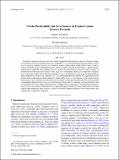| dc.contributor.author | Zhang, Fuqing | |
| dc.contributor.author | Emanuel, Kerry Andrew | |
| dc.date.accessioned | 2018-04-06T13:35:06Z | |
| dc.date.available | 2018-04-06T13:35:06Z | |
| dc.date.issued | 2016-09 | |
| dc.date.submitted | 2016-06 | |
| dc.identifier.issn | 0022-4928 | |
| dc.identifier.issn | 1520-0469 | |
| dc.identifier.uri | http://hdl.handle.net/1721.1/114579 | |
| dc.description.abstract | The skill of tropical cyclone intensity forecasts has improved slowly since such forecasts became routine, even though track forecast skill has increased markedly over the same period. In deciding whether or how best to improve intensity forecasts, it is useful to estimate fundamental predictability limits as well as sources of intensity error. Toward that end, the authors estimate rates of error growth in a "perfect model" framework in which the same model is used to explore the sensitivities of tropical cyclone intensity to perturbations in the initial storm intensity and large-scale environment. These are compared to estimates made in previous studies and to intensity error growth in real-time forecasts made using the same model, in which model error also plays an important role. The authors find that error growth over approximately the first few days in the perfect model framework is dominated by errors in initial intensity, after which errors in forecasting the track and large-scale kinematic environment become more pronounced. Errors owing solely to misgauging initial intensity are particularly large for storms about to undergo rapid intensification and are systematically larger when initial intensity is underestimated compared to overestimating initial intensity by the same amount. There remains an appreciable gap between actual and realistically achievable forecast skill, which this study suggests can best be closed by improved models, better observations, and superior data assimilation techniques. | en_US |
| dc.description.sponsorship | United States. Office of Naval Research (Grant N000141410062) | en_US |
| dc.description.sponsorship | National Science Foundation (U.S.) (Grant AGS 1305798) | en_US |
| dc.description.sponsorship | United States. Office of Naval Research (Grant N000140910526) | en_US |
| dc.publisher | American Meteorological Society | en_US |
| dc.relation.isversionof | http://dx.doi.org/10.1175/JAS-D-16-0100.1 | en_US |
| dc.rights | Article is made available in accordance with the publisher's policy and may be subject to US copyright law. Please refer to the publisher's site for terms of use. | en_US |
| dc.source | American Meteorological Society | en_US |
| dc.title | On the Predictability and Error Sources of Tropical Cyclone Intensity Forecasts | en_US |
| dc.type | Article | en_US |
| dc.identifier.citation | Emanuel, Kerry, and Fuqing Zhang. “On the Predictability and Error Sources of Tropical Cyclone Intensity Forecasts.” Journal of the Atmospheric Sciences 73, 9 (September 2016): 3739–3747 © 2016 American Meteorological Society | en_US |
| dc.contributor.department | Massachusetts Institute of Technology. Department of Earth, Atmospheric, and Planetary Sciences | en_US |
| dc.contributor.department | Lorenz Center (Massachusetts Institute of Technology) | en_US |
| dc.contributor.mitauthor | Emanuel, Kerry Andrew | |
| dc.relation.journal | Journal of the Atmospheric Sciences | en_US |
| dc.eprint.version | Final published version | en_US |
| dc.type.uri | http://purl.org/eprint/type/JournalArticle | en_US |
| eprint.status | http://purl.org/eprint/status/PeerReviewed | en_US |
| dc.date.updated | 2018-03-30T17:42:43Z | |
| dspace.orderedauthors | Emanuel, Kerry; Zhang, Fuqing | en_US |
| dspace.embargo.terms | N | en_US |
| dc.identifier.orcid | https://orcid.org/0000-0002-2066-2082 | |
| mit.license | PUBLISHER_POLICY | en_US |
